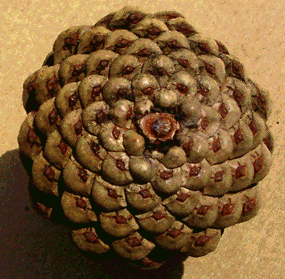Fibonacci's Pine Cone
Yesterday some of us at work were walking back from lunch and I mentioned there were rumors of a new iPod. It was going to be as thin as a nano, but the size of a squat 5G. Already people were saying how ugly it was and part of that is because it isn't a golden rectangle where the ratio of the long side to the short side is 1.618:1.

Well that got Paul talking about Fibonacci numbers and how the numbers show up in nature all over the place. Fibonacci's numbers are easy to calculate: it is just a series of numbers where the next number is the sum of the previous two: 1, 1, 2, 3, 5, 8, 13, 21, 34, 55, etc. The numbers get big pretty quickly. So he started talking about pine cones and how you can see spiral patterns in the scales if you look at the big end of a pine cone. Further he said that if you follow the spirals one way you will get 8 arms of the spiral, but if you go the other you will get 13. I didn't see how you could have different numbers of spirals on the same pine cone.
By this time we were at the Capitol, so he went and looked for a pine cone under one of the trees on Capitol Square. He brought back and started showing me how to count the arms, and sure enough there they were.
He said that all kinds of things from the heads of sunflowers to the spikes on a pineapple follow similar patterns and the numbers are usually Fibonacci numbers. I found a great site with tons of examples (and some examples of plants that don't participate in Fibonacci's conspiracy). That's also where I got the pictures of pine cones.
Comments (1)
re: "13 one way vs 8 the other."
The dimension on each spine that makes up one path is broader and less tilted. The other dimension is narrower and more tilted. So you get more arms with the latter.
If you had a square checkerboard, but the checks were skinnier one way, you'd get more rows (or columns) with those. The pine cone is a square checkerboard... kind of.
Posted by Jeb | August 27, 2007 12:41 AM